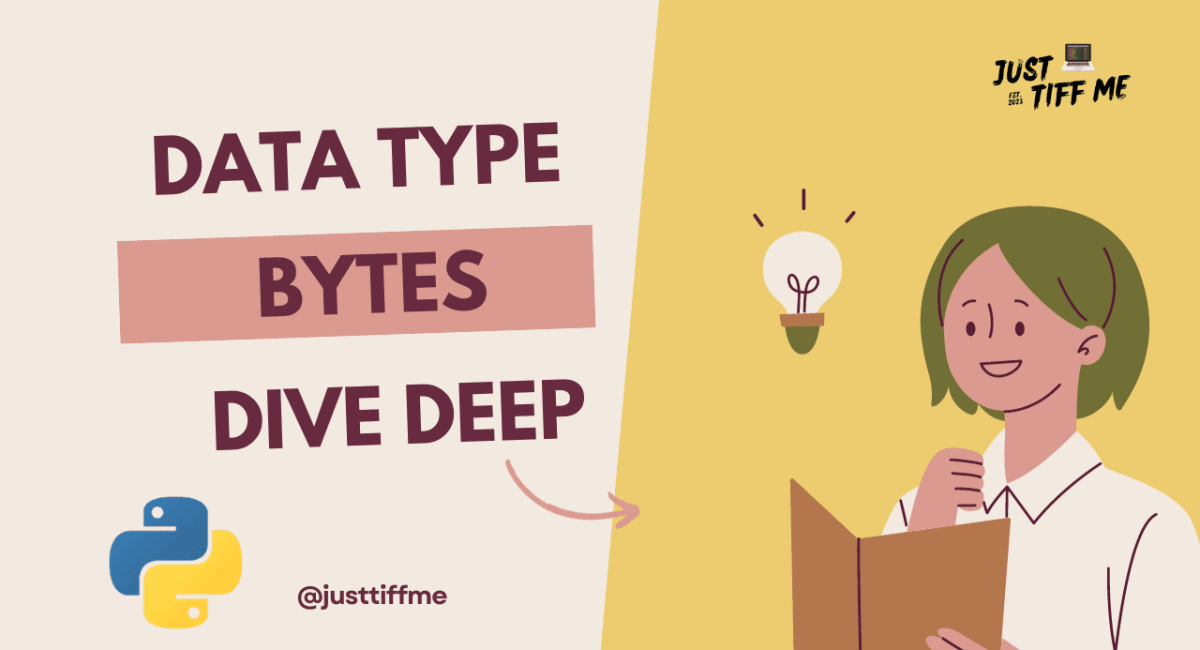In Python, bytes represent a sequence of binary data, and they are used to work with raw binary data, such as files, network protocols, or other binary formats. Bytes are similar to strings in many ways, but they are designed specifically for handling binary data rather than text.
Understanding the Byte Data Type
The byte data type represents binary data, which is essentially a sequence of raw bytes. Unlike strings, bytes are immutable, meaning their values cannot be changed after creation.
Bytes are often used to work with binary data or to interface with low-level system functions.
my_byte = b'Hello'
In this example, `my_byte` is a byte object that contains the sequence of bytes representing the string “Hello, World!”.
Creating Byte Objects
You can create byte objects by prefixing a sequence of bytes with the `b` character.
Here, we create a byte object `my_byte` by specifying the hexadecimal values for each character in “Hello.”
ASCII-encoded vs Hexadecimal byte
my_byte = b'\x48\x65\x6c\x6c\x6f' # Hexadecimal representation of "Hello"
or
my_byte = b'Hello'
Both Examples below are examples of byte objects, but they are created differently and represent the same text “Hello” in distinct ways:
1. my_byte = b'\x48\x65\x6c\x6c\x6f'
- This byte object is created using the hexadecimal (hex) representation of the ASCII values for the characters ‘H’, ‘e’, ‘l’, ‘l’, and ‘o’.
- In this representation, each character is represented by its ASCII value in hexadecimal format (base 16).
- It’s an alternative way to create a byte object from a text string, particularly when working with binary data and when you want to specify each byte’s value explicitly in hexadecimal.
2. `my_byte = b'Hello'`
- This byte object is created using the ASCII-encoded representation of the characters ‘H’, ‘e’, ‘l’, ‘l’, and ‘o’.
- Each character is represented by its ASCII value in decimal format.
- It’s a straightforward way to create a byte object from a text string using the ASCII encoding.
Both representations achieve the same result, which is creating a byte object containing the text “Hello,” but they differ in how the data is represented.
The first one uses decimal ASCII values, while the second uses hexadecimal ASCII values. The choice between them depends on your preference and the specific requirements of your code.
Manipulating Byte Data
Bytes support various operations, including slicing, indexing, and concatenation. These operations allow you to manipulate byte sequences efficiently.
Byte Operations
Here are some common byte operations in Python:
1. Accessing Individual Bytes
You can access individual bytes in a byte object using indexing, just like you would with strings.
binary_data = b'Python'
first_byte = binary_data[0] # Accessing the first byte
2. Slicing Bytes
Byte objects can be sliced to extract specific portions of binary data.
binary_data = b'Python'
sliced_data = binary_data[1:4] # Slicing bytes
3. Concatenating Bytes
You can concatenate byte objects together using the `+` operator.
byte_data1 = b'Hello'
byte_data2 = b' World'
concatenated_data = byte_data1 + byte_data2
4. Length
Finding the length (number of bytes) in a byte object using the `len()` function.
my_byte = b'Python'
length = len(my_byte) # Length is 6
5. Finding Elements
Byte objects support common operations like finding the index of a byte value.
binary_data = b'Python'
index = binary_data.index(b't') # Finding the index of 't'
6. Bytearray
If you need mutable byte sequences, you can use bytearrays. Bytearrays are similar to bytes but can be modified in place.
mutable_bytes = bytearray(b'Hello')
mutable_bytes[0] = 72 # Modifying a byte in place
7. Hexadecimal Representation
Bytes can be represented as hexadecimal strings for easy human-readable display.
binary_data = b'\x48\x65\x6C\x6C\x6F'
hex_string = binary_data.hex() # Converting bytes to a hexadecimal string
8. Iteration
Iterating through the bytes in a byte object using a `for` loop or other iteration methods.
my_byte = b'Bytes'
for byte in my_byte:
print(byte)
9. Membership Test
Checking if a specific byte is present in a byte object using the `in` operator.
my_byte = b'Python'
is_present = b'y' in my_byte # True
Converting Bytes to Other Data Types
Converting bytes to other data types, such as strings or integers, using decoding methods like `decode()` or built-in functions like `int()`.
my_byte = b'42'
my_string = my_byte.decode('utf-8') # Convert bytes to string
my_integer = int(my_byte) # Convert bytes to integer
You can convert a sequence of bytes into an integer using the `int.from_bytes()` method.
byte_data = b'\x01\x02\x03\x04'
integer_value = int.from_bytes(byte_data, byteorder='big') # Converting bytes to an integer
To convert an integer to bytes, you can use the `int.to_bytes()` method.
integer_value = 12345
byte_data = integer_value.to_bytes(2, byteorder='big') # Converting an integer to bytes
Byte's immutability
In Python, the `byte` data type is considered an immutable data type. This means that once a byte object is created, its contents cannot be changed.
Any attempt to modify the content of a `byte` object will result in the creation of a new `byte` object with the desired changes, leaving the original `byte` object intact.
# Original byte object
original_byte = b'Hello'
# Attempt to change the first byte to 'M'
try:
original_byte[0] = b'M' # This will raise a TypeError
except TypeError as e:
print(f"Error: {e}")
In this code, we start with a byte called original_byte containing ‘Hello’. We try to change the first letter from ‘H’ to ‘M’, but it raises a `TypeError`.
This error occurs because `byte` objects are immutable, and you cannot directly modify their contents using item assignment as you might with a mutable data type like a list.
To make the change, we create a new byte:
# Create a new byte object with the change
modified_byte = b'M' + original_byte[1:]
# Display the modified byte
print(modified_byte) # Output: b'Mello'
We create a new byte called modified_byte by taking the letter ‘M’ and adding the rest of the original_byte.
This approach allows us to make changes while preserving the immutability of the original `byte` object.
Real-world Applications
Bytes are extensively used in various real-world applications, primarily due to their ability to handle binary data efficiently. Here are a few scenarios where bytes shine:
Binary File Handling
When working with binary files like images, audio files, or documents, bytes are the preferred choice. Python’s ability to read and write bytes directly from and to binary files makes it a powerful tool for file manipulation.
Example: Reading an Image File as Bytes
with open('image.png', 'rb') as file:
image_data = file.read()
Network Protocols
Bytes play a crucial role in network communication, where data is transmitted in binary format. Networking libraries in Python, such as `socket`, rely heavily on bytes for sending and receiving data over networks.
Example: Creating an HTTP Request as Bytes
http_request = b'GET /index.html HTTP/1.1\r\nHost: www.example.com\r\n\r\n'
Low-Level Operations
When interfacing with hardware or low-level system functions, bytes are essential for passing data in its raw binary form. This is common in scenarios like device communication and hardware control.
Example: Writing to a Serial Port as Bytes
import serial
ser = serial.Serial('/dev/ttyUSB0', baudrate=9600)
ser.write(b'\x01\x02\x03')
Advantages of Byte Data Type
Bytes offer several advantages that make them indispensable in certain situations:
Efficient Handling of Binary Data
Bytes are designed to efficiently represent and manipulate binary data. They consume less memory compared to strings, making them ideal for working with large datasets.
Interfacing with Low-Level System Functions
In situations where you need to interact with low-level system functions or hardware, bytes are the natural choice due to their raw binary nature.
Reliable Data Transmission in Networking
In network communication, where data integrity is critical, bytes ensure that data is transmitted in its exact binary format, minimizing errors.
Disadvantages of Byte Data Type
While bytes are powerful, they also have limitations:
Limited Support for Character Encoding
Bytes do not have inherent character encoding like strings. This can lead to challenges when dealing with text that includes characters from multiple languages.
Immutability Can Be Restrictive
The immutability of bytes means that you cannot modify their contents directly. Instead, you need to create new byte objects, which can be less efficient in some situations.
Conclusion
In summary, bytes are a fundamental data type in Python used for handling binary data efficiently. Understanding their characteristics and differences from strings is essential for making informed decisions in your Python projects.
FAQs
No, bytes and strings are distinct data types and cannot be mixed directly. You’ll need to convert one to the other if you want to combine them.
You can convert a byte object to a string using the `decode()` method, specifying the character encoding you want to use.
Bytes are generally more memory-efficient when working with binary data since they don’t carry the overhead of Unicode encoding.
No, byte objects are immutable, so you cannot modify their contents. You would need to create a new byte object with the desired changes.
Bytes are most commonly used in scenarios involving binary data, such as reading and writing files, working with network protocols, and handling encryption.




